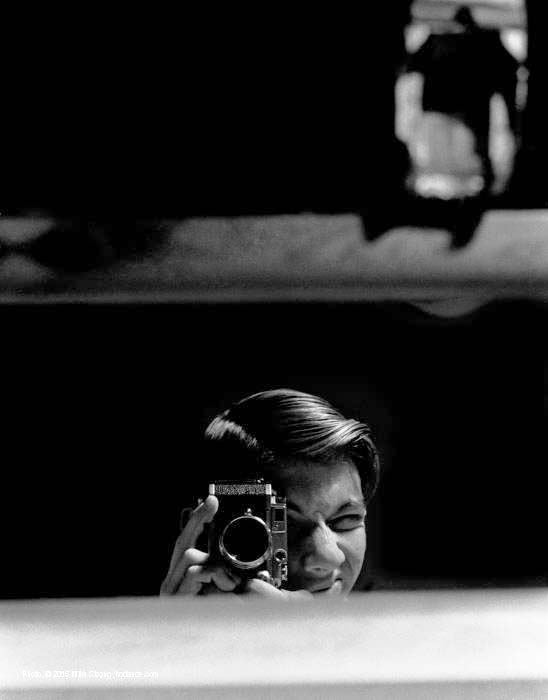 Mirror, December 1967 with Canon 35mm rangefinder, a Leica-type camera. |
Mike StrongPhoto CVStarting out - Summer 1967 |
Summer, 1967
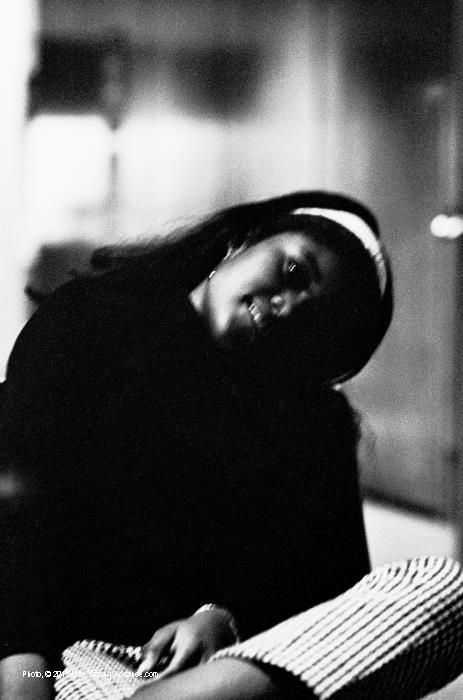 |
Summer school at the University of Nebraska Lincoln was a way to get back into school. I had started an engineering program in 1966 but didn't do so well. I suppose not missing so many classes helped that process. I wasn't so keen on math either. So I thought I could change majors to broadcast journalism. No math there - though karma would later put me in a math job in the Air Force. As part of the new major I took a photo course that summer. I spent so much time in the lab I was asked to be a lab assistant for the 67-68 year. I was 19. I took to it.
Those slight motion blurs in my pictures go all the way back to the start. Here is "Marv's Girl" (at left) taken in Smith Hall. Yes I have other pictures in which she is clear but I really like the sense of this one. And no, I don't remember her name. She was very nice. Marvin was one of the UN football players and was in the same dorm as me. |
Sara Schwieder (right) was in the Civil Air Patrol which I had joined in Columbus when I was 13. She was in the Lincoln squadron and is pictured here in the record store where she worked after school. As I recall her mother was an editor with Bison Books, the University of Nebraska publishing arm. Sara was also kind enough to sit for my portrait assignment (below). |
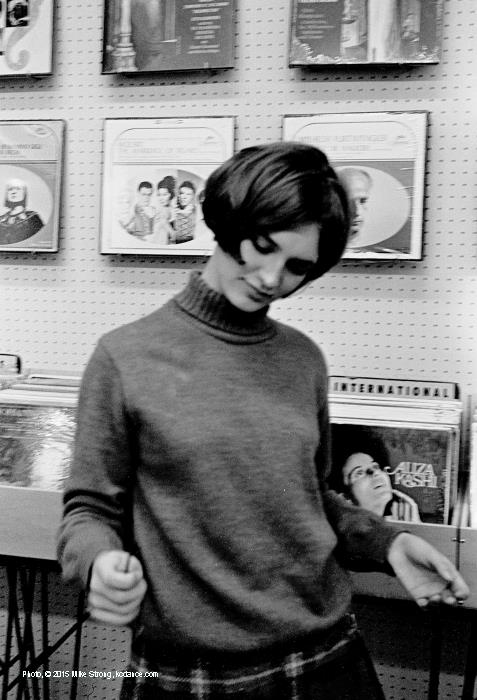 |
The only camera I could afford at that time, an Agfa 35mm rangefinder didn't focus properly. I soon traded it that fall for a Canon rangefinder (a Leica imitation type) which had shutter-bounce problems. The camera store couldn't fix it so I traded in the camera for a set of Nikon extension tubes (to shoot close-ups) and saved for a new Nikon which I bought mailorder in August the next year from 47th St. Photo in NYC. In the meantime I borrowed cameras. I also borrowed light meters until I had memorized light settings in various situations.
Here he is helping a student. The reels in the top photo are 16mm film. The boxes in the image to the left are 4x5 film boxes and behind on the bench you can see the flash units for the Crown and Speed Graphics we learned on. Click Here for a slightly larger version of this picture. |
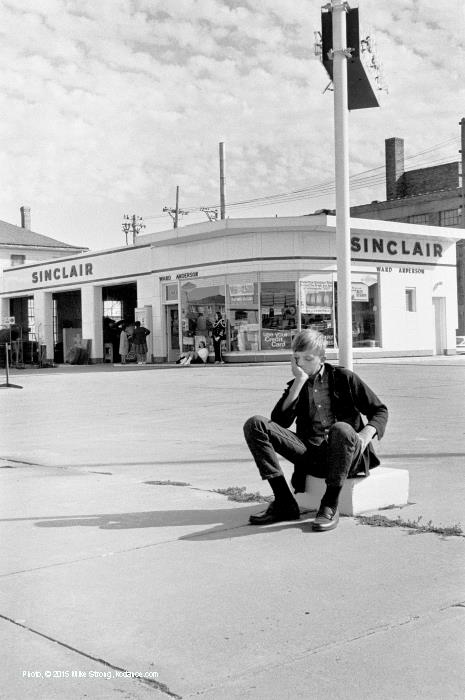 The Corner Seat |
On her lap Sara is holding a Kodak view camera. View cameras give all sorts of movements which allow a great deal of control over the way the image looks. Even though she looks good and I liked the pictures with her face, I've always liked this unintentional abstraction with the gray card in front of her face. This picture was shot with another of those Kodak view cameras. To see the picture at the left either click the picture or click here.
|
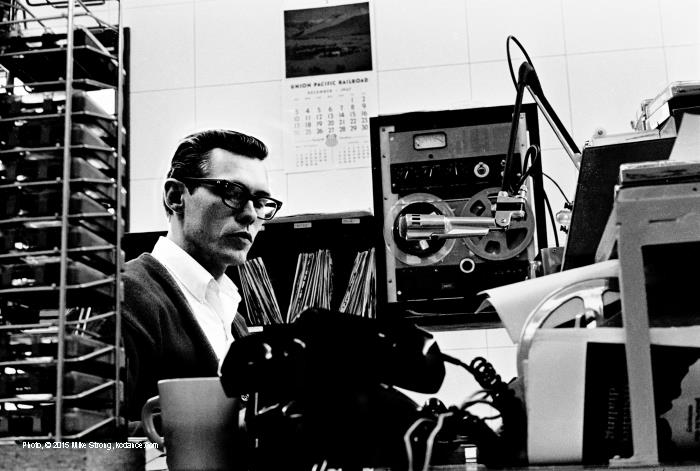 LEFT - Ron Kruse at KTTT in late December 1967. I would work there in 1968. Those are carts in the rack on the left, albums for immediate play behind, a reel-to-reel for canned programs. The calendar is from Union Pacific. Trains were still important transportation in 1967. |
RIGHT - Couple in a window of the dormitory cafeteria in 1967, just outside the entrance point.. |
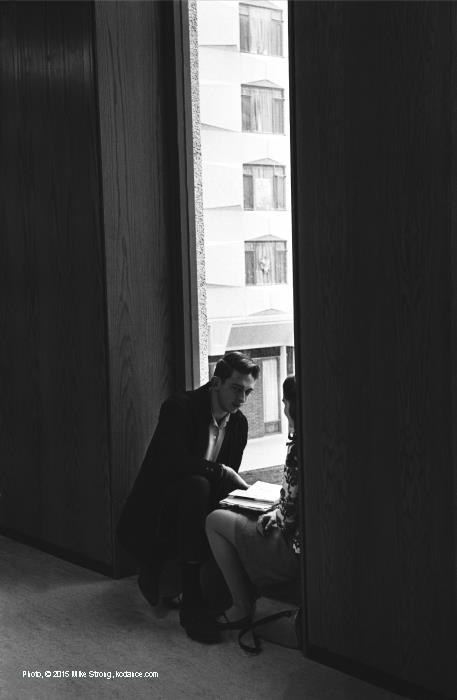 |
1968
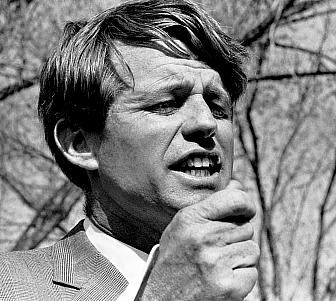 |
|
Most of the Kennedy shots were done at about 4 feet. Because the focusing/parallax correction for the 105mm lens took so much time I just set the focus and moved the camera to remain at the same distance. I learned early on to estimate distances for a pre-set focus. Truth is that I put these pictures away for a long time because I thought they were a bit too formulaic and also because it seemed like "picture" dropping. I like them better now and I wanted you to see what I was doing at age 20 to get a sense of the continuity between then and today. This was also where I learned how to move like a news photog. I have a long series of shots on this visit both inside and outside. These shots were taken as Kennedy stood in the back seat of a pale yellow convertible in front of the auditorium where he was about to make a speech. A network TV camera man (film camera) with his sound man were next to me on my left. At that time a network photog earned about $350-$500 a day. The camera guy was using an Auricon 16mm sound camera with 400-foot magazines.
I gulped and followed. I looked down at the driver as he saw me take the same route. He looked up at me, wide eyes and a bit helpless. I went on but never forgot his expression. From there it was into the auditorium and on to the stage, again from about four or five feet below the podium position. I had just learned "how the big boys" do it. |
|
I didn't stay in school. I joined the staff of KTTT in Columbus, Nebraska as a news reporter/DJ/gopher. I had a regular round of places to go to pick up the police blotter and other small news. Part of the day I wrote, read and "ripped and read" news. Part of the day I played records. Every afternoon it was my job to play "Al Grebnik and the Boys" - a polka group. Some of the job was simple production.
By this time I was ready to enlist. I had been in the Civil Air Patrol seven years. The Air Force was a natural. On November 7, 1968 I reported to the recuiting station in Omaha, Nebraska. We were shipped to basic training at Lackland AFB in San Antonio, Texas. After basic came tech training. I was sure that I would be a photographer. The recuiter had promised me. More than that, I developed a roll of "risky" film for him - stuff that is pretty much standard in today's ads for darn near any product. I thought the fix was in. I had never hear of geodetic computers - or as the army called them, topographic computers. I thought that getting out of engineering freed me from mathematics. Life has its own sense of humor.
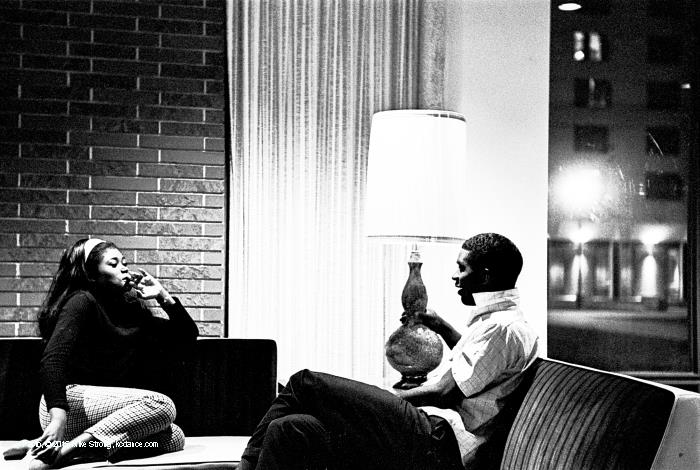
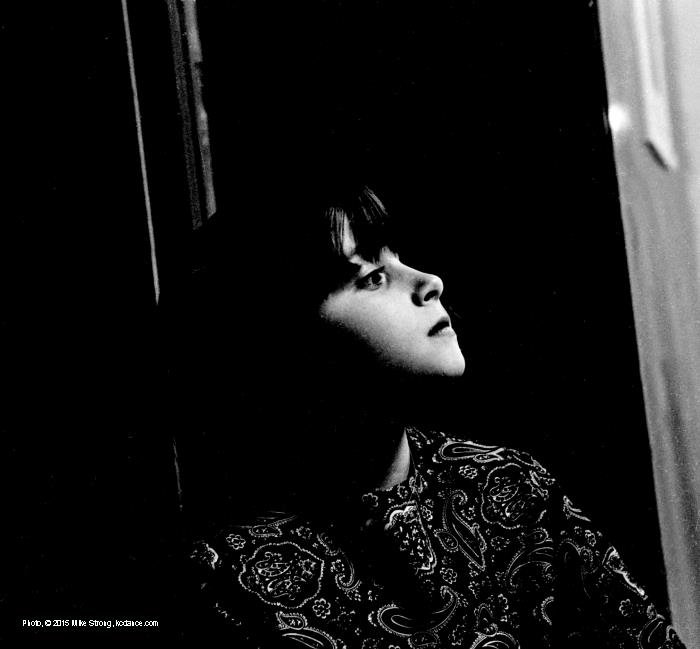
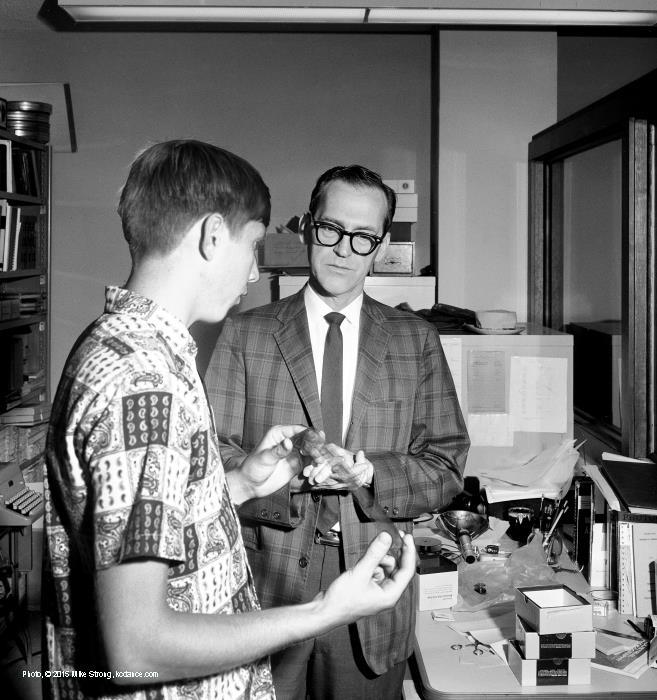
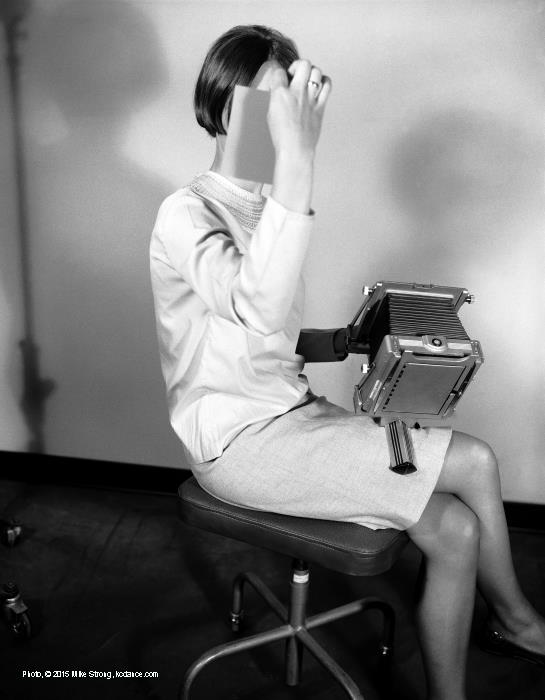 In the student studio. Sara is holding a gray card in front of her face so that I can have a reference gray to use in the darkroom to get the correct density (and, in a color darkroom, as a neutral reference). Gray cards reflect 18% of the light which hits them (about the same as a newspaper want-ad page). All light readings for cameras are based on this index point.
In the student studio. Sara is holding a gray card in front of her face so that I can have a reference gray to use in the darkroom to get the correct density (and, in a color darkroom, as a neutral reference). Gray cards reflect 18% of the light which hits them (about the same as a newspaper want-ad page). All light readings for cameras are based on this index point.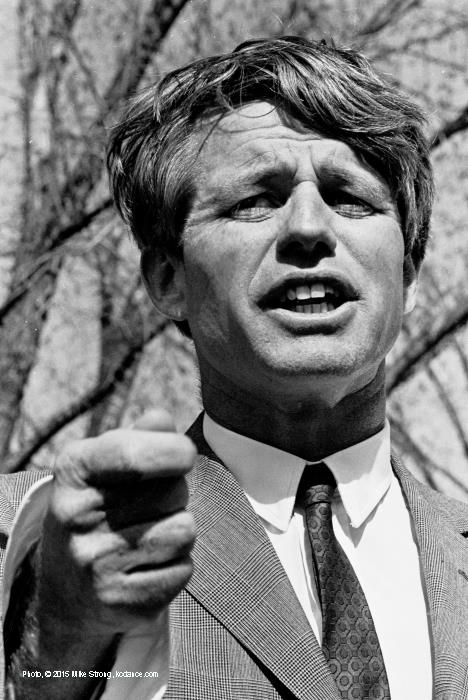
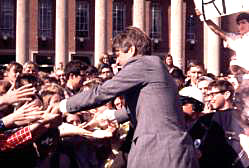 I shot these pictures with a Contax 35mm rangefinder from the J-School. The Contax had the first metal focal plane shutter with a vertical travel. It also had a wide, knurled wheel rather than a lever to advance the film. The technique for that was to use your forefinger to roll along the wheel, winding the film and cocking the shutter. I was using a Nikon 105mm F2.5 p-series lens at the time. To view the shot a separate viewfinder was mounted above the camera and you had to keep turning a parallax-correcting dial for each focusing distance. I also carried a Canon rangfinder I bought with a 50mm lenses so I could shoot color film as well.
I shot these pictures with a Contax 35mm rangefinder from the J-School. The Contax had the first metal focal plane shutter with a vertical travel. It also had a wide, knurled wheel rather than a lever to advance the film. The technique for that was to use your forefinger to roll along the wheel, winding the film and cocking the shutter. I was using a Nikon 105mm F2.5 p-series lens at the time. To view the shot a separate viewfinder was mounted above the camera and you had to keep turning a parallax-correcting dial for each focusing distance. I also carried a Canon rangfinder I bought with a 50mm lenses so I could shoot color film as well.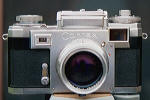 As RFK turned to his right to exit the car the network crew opened the driver's door of the convertible (for structural reasons convertibles only have two doors so the front seats fold forward to let people into the back). I remember a startled look on the driver's face as the network crew pushed the back of the drivers seat forward, shoving the driver toward the front right floor area. This opened enough room for the crew to clamber into the back, behind the driver and then follow Kennedy out the other side of the car. They all but walked on the driver.
As RFK turned to his right to exit the car the network crew opened the driver's door of the convertible (for structural reasons convertibles only have two doors so the front seats fold forward to let people into the back). I remember a startled look on the driver's face as the network crew pushed the back of the drivers seat forward, shoving the driver toward the front right floor area. This opened enough room for the crew to clamber into the back, behind the driver and then follow Kennedy out the other side of the car. They all but walked on the driver.